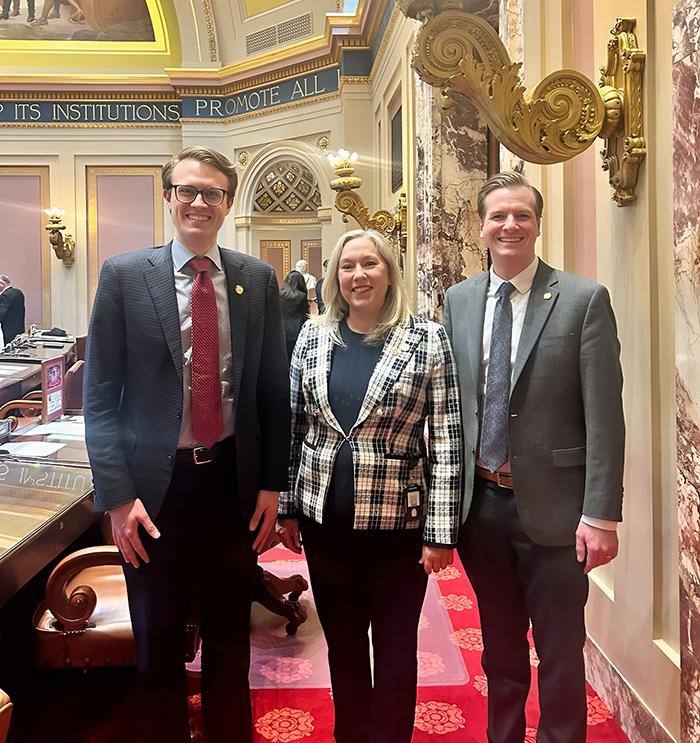State funding to assist EMS in rural Minnesota
News | Published on May 28, 2024 at 12:24pm EDT | Author: frazeevergas
0
A bipartisan group of state senators celebrate the $30 million aid package for rural emergency medical services (EMS). L-R: Senator Jordan Rasmusson (R-Fergus Falls), Senator Judy Seeberger (DFL-Afton) and Senator Grant Hauschild (DFL-Hermantown).
With strong bipartisan support, the Minnesota Legislature recently passed a $30 million aid package for rural emergency medical services (EMS), which includes more than $4 million for West Central Minnesota. This legislation, authored by Senator Jordan Rasmusson (R-Fergus Falls) and a bipartisan group of legislators, provides $24 million in emergency aid for EMS providers who are focused on services in Greater Minnesota. Another $6 million is dedicated to an innovative sprint medic pilot program for Otter Tail, Grant and St. Louis counties.
“We are thankful for the passage of this bill and grateful for the leadership of Senator Rasmusson to address such a critical issue for the residents of Otter Tail County,” said Otter Tail County Commissioner Kurt Mortenson.
Throughout the interim, a bipartisan EMS Task Force, including Sen. Rasmusson, investigated how the state can improve the life-saving services provided by EMS personnel. The Task Force was created following a 2022 EMS report from the Office of the Legislative Auditor (OLA). Field hearings were held throughout the state, and Sen. Rasmusson invited the Task Force to hear from constituents at a hearing in Grant County.
“Access to emergency medical services is crucial for Greater Minnesota, but providing these services in our rural areas is much more challenging,” Sen. Rasmusson said. “After hearing the concerns of Minnesotans, the EMS Task Force made key recommendations, many of which are reflected in the Senate’s EMS aid package. I am grateful to the Minnesotans who engaged in the listening sessions we held across the state. Their feedback allowed us to better recognize what is driving a lot of the crisis today.”
Notably, the legislation provides $24 million in emergency aid for EMS providers who primarily serve Greater Minnesota communities. As reported by the Star Tribune, Sen. Rasmusson created the mathematical formula to determine which districts will receive the money. Senator Judy Seeberger (DFL-Afton) and Senator Grant Hauschild (DFL- Hermantown) also thanked Sen. Rasmusson for his support and help on this effort. While the aid package will help, the state can only supplement funds for rural EMS. Overall, the funding remains a federal issue with government reimbursement rates failing to cover the total cost of care.
“With the approval of this $30 million EMS aid package, we are extending a lifeline for this critical service. This funding proposal is transparent and prioritizes rural communities that need the most help. I appreciate the collaborative nature of this legislation and the opportunity to work on this issue in a bipartisan manner,” Sen. Rasmusson added.
The EMS aid package also includes $6 million to launch a sprint medic pilot program in Otter Tail, Grant and St. Louis counties. The pilot program authorizes trained medical staff to be the first response and determine if an ambulance is necessary. This will help connect Minnesotans to care more quickly and ensure the correct level of care is provided. The mobile and flexible approach also aims to reduce unnecessary ambulance calls that ultimately may not be reimbursed.
“We are excited that Otter Tail County will receive $3 million to operate one of two Sprint Medic Pilot Projects which will serve Otter Tail and Grant counties,” said Perham Area EMS Director Rebecca Huebsch. “The Sprint Medic model will provide geographic equity and rapid response by ensuring advanced life support coverage is distributed evenly across all service areas. Advanced life support coverage will be provided by dedicated paramedics that will operate in a roving “sprint car” staffed by a paramedic in predefined response areas. This would not have been possible without Senator Rasmusson’s leadership.”
Additional reforms in the bill help address EMS staffing concerns in rural areas. The changes make it easier to be qualified or certified as an Emergency Medical Technician (EMT), Emergency Medical Responder, or Ambulatory EMT.
The OLA report found the EMS Regulatory Board (EMSRB) was ineffective in its regulatory role. Therefore, the EMS aid package also starts to address these issues with a restructuring of the EMSRB. The powers and duties of the EMSRB are moved to a newly established Office of Emergency Medical Services.
The legislation received unanimous support in the Senate, and it now goes to the governor’s desk and awaits his signature.

